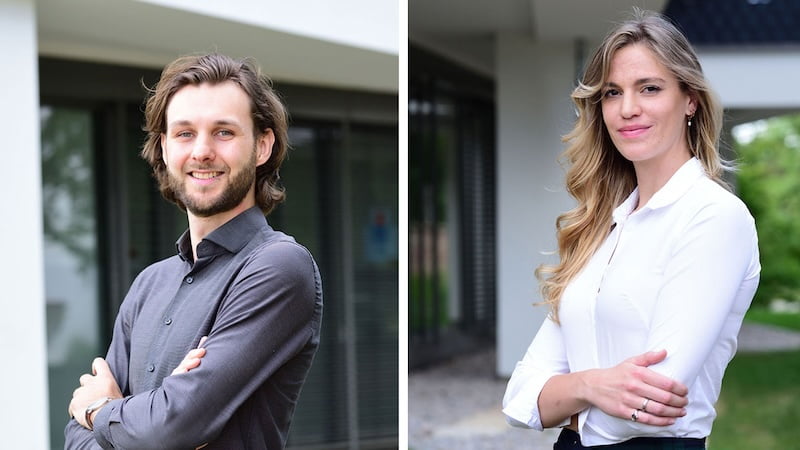
In the “Start-up Check!” series, we regularly examine the business models of start-ups. Who is behind the company? What makes the start-up so special and what is there to criticize? Today: myScribe
Start-ups: That sounds like inventiveness, future technologies, new markets. But in reality, many of the start-ups unfortunately often turn out to be a mixture of an e-commerce idea, haphazard founders and shaky future prospects.
But they certainly do exist: the thought leaders who work on the big problems and revolutionize business models. Finding and presenting these is the task of the Start-up Check format. Today: myScribe from Mannheim.
Who is behind myScribe?
This is myScribe:
- Company headquarters: Mannheim
- Founded: 2023
- Founding team: Ira Stoll (CEO) and Lars Stoll (CTO)
- Number of employees: 9
- Product(s): myScribe app, myScribe care app
Up to three hours of documentation every day, manually compiling handwritten notes, voice memos and laboratory results in a well-known word processing program. This is how Ira Stoll from Mannheim experienced her first weeks as a young assistant doctor after completing her medical studies in Heidelberg. And after a short time, in frustration, she considered giving up her job again.
It's not just her. Around a quarter of all doctors in German hospitals are so dissatisfied with their daily work, especially the important yet time-consuming documentation, that they are thinking about quitting.
No wonder: With four to six hours a day spent on patient files, doctor's letters, discharge management, etc., there is really little time for the actual tasks of (prospective) doctors: looking after patients, carrying out operations.
When Ira did an internship at Harvard University in Boston in fall 2018, she came into contact with the so-called “scribes” in everyday clinical life there. These include, for example, medical students or first-year assistant doctors who accompany their trainers or senior physicians throughout the day with pads, pens and dictaphones and thus support them with documentation.
That left a lasting impression. How could the principle of scribes be transferred to a sensible digital solution? Together with her partner and web developer Lars Stoll and the AI specialist Hussein Alhasan, the idea came about to develop an app that would bring doctors back the joy of their job.
What does myScribe do?
The founding team's promise sounds fantastic: over 50 percent possible time savings in daily documentation work for doctors. But how is that supposed to work?
The myScribe app is based on a self-developed NLP (Natural Language Processing) model. This collects the information from various sources (notes from visits, laboratory results, imaging procedures, diagnoses, patient history, medication, etc.) and translates it into full-fledged, often page-long doctor's letters in just a few seconds.
It can even do this with a higher quality on average than if a human had done the writing. Because people are known to make mistakes. This method is an open secret and a good example of potential error susceptibility: In order to save at least a little time, many people resort to existing doctor's letter text modules.
Individual doctor's letters with AI
However, this involves risks: in the worst case, errors are copied or information is not exchanged correctly. myScribe, on the other hand, is not a fill-in-the-blank program; each doctor's letter is written individually.
But take another step back: Is the current situation in the German healthcare system really that bleak? In a lecture at a conference of the FAZ (Frankfurter Allgemeine Zeitung), Ira vividly reported how inadequate many current hospital information systems (HIS) work.
They do not provide an overview of therapies, visit progress notes or diagnoses and do not allow for the possibility of integrating care tasks, which leads to the ongoing need for handwritten patient files.
This is where myScribe comes into play with the aim of positioning itself as a “single source of truth”. Using modern interfaces, all the information actually enters the app in a structured form and is further processed there. The high-quality AI doctor's letter is myScribe's central product promise, but by no means everything that the revolutionary app can do.
What makes myScribe so special?
With her practical experience as a doctor, Ira Stoll knows exactly where the problems arise in everyday hospital life. For example during the visit. This was not possible without analog patient files – and not all of the information was clearly available at all times.
This is also where myScribe comes in. Since all the information relevant to the doctor's letter must be available in the app, it can just as easily be displayed in a clear patient profile that can be accessed on a tablet. In addition, the entire medical workflow can be displayed here: forms, such as the patient anamnesis, can be handled digitally via myScribe.
We all know it from visits to a new doctor's office – the good old paper registration form. At least in hospitals, this method could also be used to add new information or enter tasks for nursing staff into myScribe.
In order to make the myScribe offering even more holistic, the now nine-strong team is also working on an app for nursing staff in order to provide them with the best possible relief through digital processes.
Are there any points of criticism?
In my opinion, there is no criticism of the app and the founders' plans – our healthcare system urgently needs digital solutions in order to be able to work better, to remain internationally competitive (or better, to become competitive again!) and to help doctors like founder Ira Stoll Maintaining joy in the job.
But it is precisely the current system that could put obstacles in the way of myScribe or at least slow down its growth. Now it gets a little technical: In order for myScribe to be able to communicate with the existing HIS, i.e. to extract data from it and return it, the hospital needs the modern interoperability standard FHIR (pronounced like “fire”, stands for Fast Healthcare Interoperability Resources).
This is set to become the new standard in Germany and has already established itself in the USA. With FHIR, outdated data exchange technologies would finally be a thing of the past. But it is not yet clear whether and, above all, when FHIR will be able to establish itself nationwide. (As usual, it's about data protection, among other things.) Ira Stoll hopes that this will happen. A conversation with Federal Health Minister Karl Lauterbach was already positive.
So myScribe, the start-up app, only “speaks” FHIR – is that a good thing? The renowned Fraunhofer Institute is also working on an AI for doctor's letters, but it does not rely on FHIR. However, there seem to be even more weak points here. The Fraunhofer AI collects all the information using “text mining”, but the doctor still has to write the epicrisis. Well so what!
Otherwise, the only thing that gives me pause is myScribe's pricing model, which is supposed to work according to the pay-per-use principle, i.e. it charges for each doctor's letter created. However, practical use will have to show whether this is user-friendly in the long term.
Conclusion: myScribe from Mannheim
Around 200,000 people work in the medical service at German hospitals. If, as promised by myScribe, they were able to save around three hours a day thanks to AI, this would benefit many: the patients, who would receive more attention, and the doctors, who would find more joy in their job again with less documentation effort. Ira Stoll herself says that she can imagine working as a doctor again, but of course only if the clinic uses myScribe.
The success story of the young company so far, which was only founded at the beginning of 2023, gives cause for optimism and points to a promising future: myScribe has already won several start-up awards, including the mexi, the Mannheim business start-up award, and second place at the German Medical Award . The company is also close to completing a seed financing round worth millions.
One hospital has already successfully implemented myScribe. The app will be further improved and expanded in close collaboration with the doctors there. Many more are expected to follow this year and next – the Hospital Future Act, which has existed since 2020 and which makes the implementation of myScribe for clinics fully eligible for funding, will certainly help.
It remains to be seen how long the healthcare system in this country will be “FHIR-ready” in order to successfully integrate apps like myScribe and other useful software applications in hospitals. With all the requirements and guidelines that need to be met, this currently seems to be a mammoth task. The law to accelerate the digitalization of the healthcare system passed in December 2023 is definitely a big step in the right direction.
Also interesting:
Source: https://www.basicthinking.de/blog/2024/03/08/start-up-check-myscribe-will-krankenhaus-dokumentation-mit-ki-revolutionieren/


